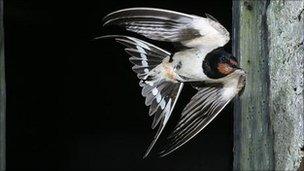Climate risks greater for long distance migratory birds
- Published

Swallows are among the species that make long distance migrations to northern Europe
Birds embarking on long distance migrations are more vulnerable to shifts in the climate than ones making shorter journeys, a study suggests.
Scientists say the increasingly early arrival of spring at breeding sites in Europe makes it harder for the birds to attract a mate or find food.
The researchers warn that the "increasing ecological mismatch" can lead to a decline in bird populations.
The findings appear in the journal Proceedings B of the Royal Society.
"The study was based on a very large dataset of 117 migratory bird species that migrate from Africa or southern Europe to northern Europe, covering about 50 years," explained co-author Nicola Saino, from the University of Milan.
The international team of researchers, from Italy, Germany, Finland and Russia, wanted to see if the spring arrival time of the birds at their breeding sites had changed over the past half century.
To achieve this, they used the birds' average arrival days at a number of bird observatories in northern Europe.
The team then compared this information with the corresponding year's "degree days", which refers to the total of average daily temperatures above a threshold that will trigger natural cycles, such as plants coming into leaf or flower.
"We know that temperatures affect the progress of spring - the higher the temperatures in the first months of the year, the earlier spring arrives," Professor Saino told BBC News.
'Missed opportunities'
Earlier this year, researchers from the UK's Centre for Ecology and Hydrology published a study that suggested that spring was arriving in the UK 11 days earlier than 30 years ago.
Professor Saino and the team found that spring was beginning earlier, which had a consequence for the migratory birds.
"The birds that have not kept track with the changes have declined more in northern Europe."
These were primarily species making long distance migrations from sub-Saharan areas, a diverse set including ducks, swallows and warblers.
"The most likely problem is that there is optimum time in spring for the birds to breed; and by arriving late, the birds are probably missing the best period in which to breed," he said.
"Peaks in food abundance, such as insects, are very narrow in northern latitudes; so if you arrive too late and miss the peak, then you miss the best opportunity to raise your offspring.
He added that this "ecological mismatch" was likely to be the main reason for the decline in the birds' populations.
The data show that the birds are reaching the breeding sites earlier, but not early enough to keep aligned with the advance of spring.
The long-term consequence could be that populations continue to decline, but Professor Saino cautioned that it was a complex issue.
"It also depends a lot on what is happening in the winter," he suggested.
"One of the reasons why they might not be able to keep track of the changes is that they are unable to shift their winter sites northwards.
"Or they may have to shift their wintering sites southwards, which will make their journey longer."